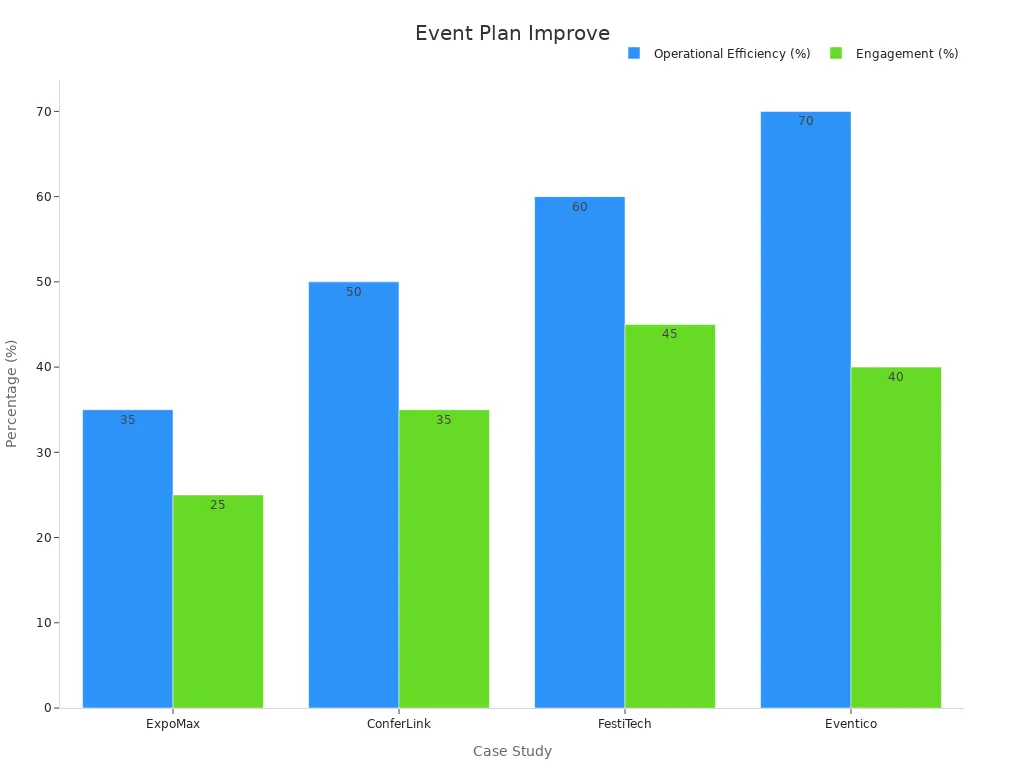
Smart meetings use technology and data to make meetings more efficient and engaging. They help you plan better, keep attendees interested, and make decisions faster. For example, shorter meetings are becoming more common, with 45% lasting only 30 minutes by 2025. Smaller groups, often with six or fewer participants, also improve focus and productivity. These trends show how smart meetings create meaningful discussions while saving time.
Productive meetings not only boost efficiency but also improve job satisfaction. Over half of employees feel more engaged and inspired when meetings are well-organized.
Smart meetings also transform corporate event planning. Virtual tools have increased attendance by 97% and expanded global participation by 78%. These innovations streamline processes and create memorable experiences for attendees.
Smart meetings use tech to boost focus and teamwork in meetings.
Shorter meetings with fewer people help everyone stay focused and happy.
Smart meetings use data to create events that fit what people want.
To start smart meetings, pick good tools and train your team well.
Checking results and improving plans makes smart meetings work even better.
Smart meetings are modern, technology-driven gatherings designed to improve productivity and engagement. They use advanced tools to simplify processes and create seamless experiences for attendees. Unlike traditional meetings, smart meetings focus on efficiency and innovation. They aim to reduce wasted time and enhance collaboration.
Key features of smart meetings include:
Immersive experiences with high-quality video and audio.
One-button joining for quick and easy access.
Contactless entry using touch-joining via mobile devices.
Smart video capabilities like auto-framing and auto-tracking.
Automatic transcription and translation of audio.
Wireless content-sharing from smartphones and tablets.
Automatic recording of meeting content for future reference.
These features make smart meetings more accessible and effective, ensuring every participant can contribute meaningfully.
Smart meetings rely on cutting-edge technologies to deliver their benefits. Video conferencing platforms with AI-powered tools play a central role. For example, auto-framing cameras adjust to keep speakers in focus, while real-time transcription tools ensure everyone stays on the same page. Mobile apps allow attendees to join meetings with a single tap, eliminating delays.
Other technologies include cloud-based collaboration tools for sharing documents and ideas instantly. Wireless presentation systems enable participants to share content directly from their devices. These innovations make smart meetings adaptable to both in-person and virtual settings, ensuring flexibility for modern workplaces.
Smart meetings differ significantly from traditional meetings in terms of outcomes and efficiency. For instance, companies that implement no-meeting days report productivity increases of 35% with one day and up to 73% with two days. This shows how strategic planning and technology can reduce meeting fatigue.
A comparison of preferences also highlights the shift. In 2020, 29% of workers preferred Tuesdays for meetings, while 47% disliked Mondays. Smart meetings consider such insights to schedule events at optimal times, improving attendance and engagement.
Statistic | Value |
|---|---|
Preferred meeting day (Tuesdays) | 29% |
Disliked meeting day (Mondays) | 47% |
Productivity increase with 1 no-meeting day | 35% |
Productivity increase with 2 no-meeting days | 71-73% |
By leveraging data and technology, smart meetings create more productive and enjoyable experiences compared to traditional approaches.
Smart meetings simplify event planning by automating repetitive tasks and streamlining operations. Event management software, used by over 85% of planners, plays a crucial role in organizing schedules, managing registrations, and tracking attendee data. These tools reduce manual work, allowing you to focus on creating impactful experiences.
Statistic | Source |
|---|---|
Over 85% of event planners use event management software, highlighting its importance in streamlining operations. | Momencio |
72.5% of organizers acknowledge the significant impact of their event platform in achieving positive results at recent conferences. | Bizzabo |
Case studies further demonstrate these benefits. For example, ExpoMax achieved a 35% improvement in traffic management and a 25% boost in engagement by using AI for real-time adjustments. Similarly, Eventico reduced check-in times by 70%, enhancing the overall attendee experience.

Smart meetings elevate attendee engagement through personalized experiences and real-time feedback. Tools like spot surveys and heat maps provide immediate insights into attendee preferences, enabling you to make on-the-spot adjustments. Metrics such as live stream watch time and poll votes help measure engagement levels effectively.
Attendance metrics, including tickets sold and revenue generated.
Engagement tracking to assess networking effectiveness and knowledge retention.
For instance, ConferLink reported a 50% increase in networking activities and a 35% rise in attendee satisfaction by offering personalized agendas and relevant networking matches. These innovations ensure that every participant feels valued and engaged.
Smart meetings optimize resources by reducing unnecessary expenses and maximizing ROI. Hybrid events, which combine in-person and virtual elements, are a prime example. According to Markletic, 86% of B2B organizations see a positive ROI from hybrid events within seven months. This approach minimizes travel costs while expanding your audience reach.
Additionally, technologies like predictive analytics and AI-driven tools help allocate resources more effectively. By automating processes and providing actionable insights, smart meetings enable you to achieve more with less.
Smart meetings empower you to make better decisions by leveraging data-driven insights. These insights help you understand attendee preferences, measure event success, and plan future strategies effectively. By analyzing data, you can identify what works and what doesn’t, ensuring every event delivers maximum value.
One of the most impactful benefits of data is personalization. Studies show that 71% of consumers prefer personalized experiences, while 76% feel frustrated when events lack this element. By using attendee data, you can tailor agendas, recommend sessions, and create networking opportunities that resonate with participants. This approach not only improves satisfaction but also boosts engagement.
Data also plays a crucial role in evaluating return on investment (ROI) and refining strategies. Organizations that use analytics are 19 times more likely to achieve profitability. Events planned with data insights consistently outperform those that rely on guesswork. For example, tracking attendance patterns and session popularity helps you allocate resources more effectively.
Insight | Description |
|---|---|
Personalization | 71% of consumers want personalized experiences, and 76% feel frustrated when they don’t get them. |
ROI and Strategy | Data-driven organizations are 19x more likely to be profitable, and events planned with analytics outperform those that aren’t. |
Competitive Edge | Data helps identify what makes your event stand out in a crowded market. |
Predictive analytics takes this a step further by using algorithms to analyze past events. This allows you to anticipate future outcomes with greater accuracy. For instance, you can predict attendance numbers, identify trends, and prepare for potential challenges. By understanding patterns, you stay ahead of the curve and maintain a competitive edge.
Data analytics ensures your event aligns with attendee needs.
Identifying trends helps you anticipate future outcomes.
Predictive tools analyze past events for accurate forecasting.
Smart meetings make it easier to collect and analyze data, giving you the tools to make informed decisions. With these insights, you can create events that not only meet expectations but also exceed them.
Selecting the right tools is the foundation of implementing smart meetings. Start by identifying your event's specific needs. For instance, if you host hybrid events, choose platforms that support seamless integration of in-person and virtual attendees. Look for features like real-time transcription, auto-framing cameras, and wireless content sharing. These tools ensure smooth communication and collaboration.
AI-powered technologies can further enhance your meetings. Predictive analytics tools help you anticipate attendance and engagement trends. Cloud-based platforms simplify document sharing and allow participants to collaborate from anywhere. By investing in the right technologies, you create a streamlined and efficient meeting experience.
Introducing smart meetings requires proper training for your team and stakeholders. Begin by familiarizing them with the tools and technologies you plan to use. Offer hands-on workshops or online tutorials to ensure everyone understands how to operate the systems effectively.
Encourage your team to explore features like real-time feedback tools and data analytics dashboards. This helps them make informed decisions during events. Regular training sessions also keep your team updated on the latest innovations. When your team feels confident using these tools, they can focus on delivering engaging and productive meetings.
Integrating smart meeting practices into your corporate events involves more than just using technology. Start by setting clear objectives for each meeting. Use AI-driven tools to personalize attendee experiences and eliminate random networking. This saves time and fosters meaningful connections.
Post-event analytics play a crucial role in refining your strategies. Analyze data to understand attendee preferences and improve future events. For example, insights from heat maps and engagement metrics help you identify popular sessions and optimize your agenda. By adopting these practices, you enhance efficiency, engagement, and ROI.
Benefits of integration include:
Enhanced event efficiency and engagement.
Personalized experiences through AI-driven tools.
Data-driven insights for refining strategies.
Smart meetings are not just about technology; they are about creating meaningful and impactful experiences.
Monitoring and optimizing smart meetings ensures continuous improvement and long-term success. By tracking performance and making data-driven adjustments, you can enhance efficiency and engagement over time.
Start by identifying key performance indicators (KPIs) that align with your meeting goals. Use tools like dashboards to visualize and analyze these metrics effectively. For example:
Purpose | |
|---|---|
Red Measures Dashboard | Focuses on poorly performing metrics to identify and address lagging KPIs. |
KPI Dashboard Template | Visualizes performance over time, indicating the status of each measure (red, yellow, green). |
Trend Dashboard Template | Displays trends in metrics over time to identify problematic periods and their causes. |
These dashboards provide a clear picture of your meeting's performance, helping you pinpoint areas for improvement.
To optimize your meetings further, follow these best practices:
Add qualitative analysis to KPIs for better interpretation.
Send KPI reports to stakeholders before meetings for efficient discussions.
Update definitions and formulas regularly to maintain clarity.
Ensure charts highlight current data and essential information.
Reassess KPIs periodically to confirm their relevance and effectiveness.
When analyzing performance, consider different types of indicators:
Leading Indicators: Predict future outcomes using current or past data, such as customer surveys or service bookings.
Lagging Indicators: Measure results of past activities, like customer satisfaction scores or sales revenue.
Quantitative Indicators: Provide numerical measurements, such as the number of attendees or total revenue.
Qualitative Indicators: Offer subjective insights, including attendee feedback or employee satisfaction.
Regularly reviewing these metrics allows you to adapt your strategies and maintain a competitive edge. Smart meetings thrive on continuous improvement, ensuring they remain impactful and relevant.
Tip: Use predictive analytics to anticipate trends and prepare for potential challenges. This proactive approach keeps your meetings ahead of the curve.
By monitoring and optimizing your meetings, you create a cycle of improvement that benefits both your organization and attendees.

Smart tools have revolutionized the way technology conferences operate. By integrating advanced meeting technologies, organizers can achieve remarkable results. For instance, conference room analytics optimize space utilization, ensuring every session runs efficiently. Data-driven insights also help make meetings more purposeful, leading to better outcomes.
The following table highlights the benefits of leveraging smart tools during tech conferences:
Benefit | Description |
|---|---|
Conference room analytics improve the efficiency of meetings by optimizing space utilization. | |
Increased Productivity | Data-driven insights ensure that meetings are purposeful and lead to desired outcomes. |
Streamlined Resource Allocation | Helps in minimizing scheduling conflicts and better allocation of meeting resources. |
Improved Collaboration | Creates environments conducive to collaboration among participants. |
These tools not only streamline operations but also foster collaboration, making tech conferences more impactful.
Hybrid meetings combine in-person and virtual elements, offering flexibility and inclusivity. Real-time analytics play a crucial role in making these meetings successful. For example, tools like Microsoft Teams and Dynamics 365 provide instant feedback on attendee engagement. This data helps you adjust your approach during the meeting to keep participants involved.
Companies like KMS Lighthouse have successfully used these technologies. By integrating Microsoft Teams and Dynamics 365, they enhanced knowledge sharing and created content faster without switching between applications. This approach ensures that hybrid meetings remain productive and engaging for all participants.
AI-driven solutions take attendee engagement to the next level by personalizing experiences. Tools like Brella and EventBase connect attendees with similar interests, fostering meaningful networking opportunities. Augmented reality (AR) installations adapt to attendee movements, creating interactive and memorable experiences.
Here’s how AI enhances personalization:
Monitor attendee behavior to refine engagement strategies.
Recommend content based on individual interests.
Connect attendees with relevant exhibitors and peers.
For example, gamification platforms like EventScore align activities with personal goals, making events more engaging. By analyzing attendee preferences, AI ensures that every participant feels valued and connected, maximizing the impact of smart meetings.
Smart meetings redefine corporate event planning by integrating technology and data to create efficient and engaging experiences. They streamline operations, enhance attendee satisfaction, and provide actionable insights for better decision-making. By adopting these practices, you can stay ahead in a competitive landscape while delivering impactful events. Embracing smart meetings ensures your organization remains innovative and responsive to evolving needs. Start transforming your events today to unlock their full potential.
gs.